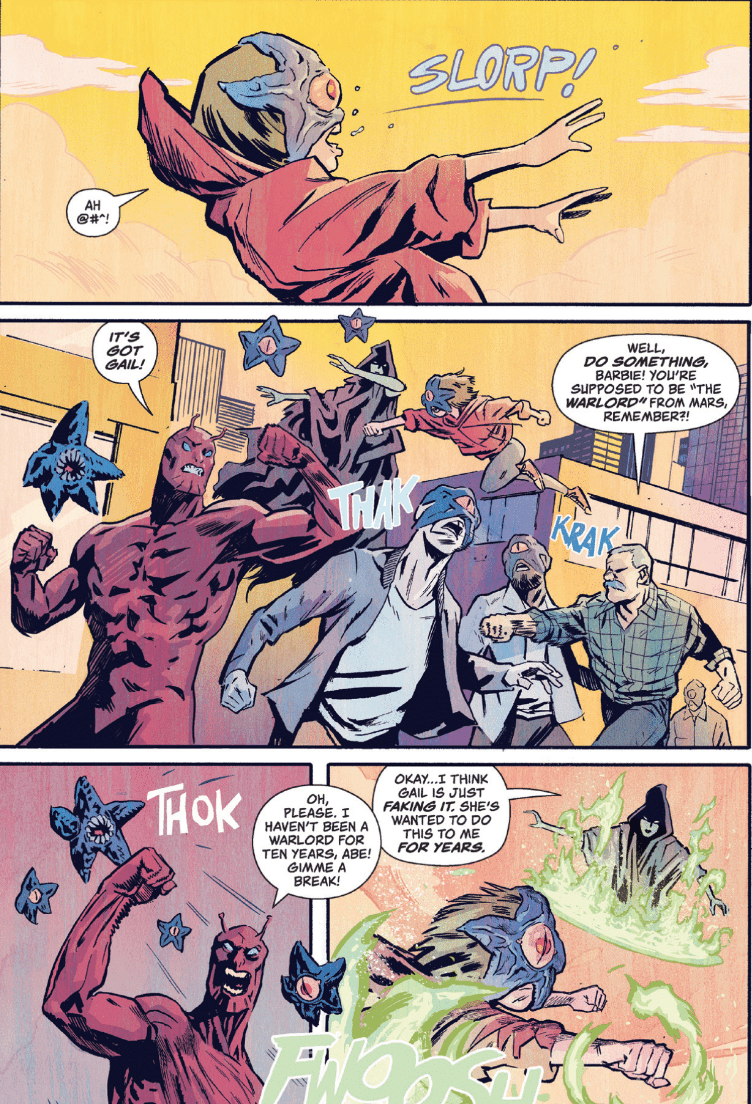Reading Black Hammer/ Justice League: Hammer of Justice #2 is a lot like watching someone play with their favorite toys. It is clear that writer Jeff Lemire has the utmost respect for this paradigmatic super team that his award-winning Black Hammer series has made a legacy of deconstructing. While it feels odd to see someone other than Dean Ormston and Dave Stewart draw and color Black Hammer’s stellar cast, artist Michael Walsh certainly puts forth a valiant effort. Black Hammer/ Justice League: Hammer of Justice #2 out this week, is definitely a slower chapter, but the revelations it is building up towards feeling seismic.
Black Hammer/ Justice League: Hammer of Justice #2 picks up initially 10 years after the events of the first chapter with the Justice League already settled into the town of Rockwood. Batman has a history with the local law enforcement as he has been previously cited for vigilantism, Wonder Woman is a schoolteacher, and Superman has settled into the role occupied by Abraham. Simultaneously, the Black Hammer crew is coping with the fact of dealing with Starro, being placed into this bizarre new world of Metropolis, and encountering the rest of the Justice League.
Lemire is clearly having a ball placing these two groups of characters in these new circumstances. The manner in which the police officer scolds Batman while he pulls him over, is a direct reflection of how ridiculous the situation is. Batman literally got pulled over for being a vigilante but not because he was pummeling the Joker instead he is investigating who was tipping cows. This light-hearted tone is also shown when Gail is potentially faking being controlled by Starro to take a swing at Madame Dragonfly and Gail’s realization that she cannot curse in this dimension.
Colonel Weird and Green Lantern’s storyline definitely seems to be the main branch for information, which is especially odd for Weird. Weird has always been the Knowing Observer who is reluctant to spill any coherent thoughts so learning how he processes information and seeing the Para-Zone is a nice look to see why he is this way. The introduction of the Bizarro Black Hammer Crew is also a nice touch.
Michael Walsh’s art is clearly inspired by Dean Ormston and Dave Stewart’s, but it definitely fails to live up to their lofty standards. Walsh’s depiction of Rockwood is really the only setting that stands out. Walsh drapes Rockwood in heavy shadows and makes clever use of setting that story around sunset/night time, adding to the lurking unease to it.

However, in daylight, the cracks are shown. And the main detraction is how certain panels have a surprising lack of detail, especially when it concerns to Aquaman and the Green Lantern Corps. I understand that the style isn’t as focused on the fine photo-realistic details of everything, but some panels are simply unfocused. For instance, when shown the entirety of the Green Lantern Corps, one is simply shown as a blue blob in the corner. Also when Green Lantern and Colonel Weird are in the Para-Zone, they point out a mystery man in pictures and he is almost undistinguishable due to the lack of focus.
It feels disingenuous to critique Black Hammer/Justice League: Hammer of Justice #2 too much as it combines two of the most well written and/or prominent super teams in creation. But something is simply not clicking the way it should. Lemire’s script is effective, punchy, and thoughtful. Walsh’s art and Nate Piekos’s letters are serviceable. But the combination of these two sensational entities is producing something just good enough, which is just a tad disappointing.

